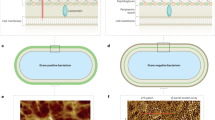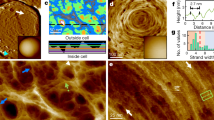Abstract
Yersinia pestis, the causative agent of plague, has been responsible for several recurrent, lethal pandemics in history. Currently, it is an important pathogen to study owing to its virulence, adaptation to different environments during transmission, and potential use in bioterrorism. Here, we report on the changes to Y. pestis surfaces in different external microenvironments, specifically culture temperatures (6, 25, and 37 °C). Using nanoscale imaging coupled with functional mapping, we illustrate that changes in the surfaces of the bacterium from a morphological and biochemical standpoint can be analyzed simultaneously using atomic force microscopy. The results from functional mapping, obtained at a single cell level, show that the density of lipopolysaccharide (measured via terminal N-acetylglucosamine) on Y. pestis grown at 37 °C is only slightly higher than cells grown at 25 °C, but nearly three times higher than cells maintained at 6 °C for an extended period of time, thereby demonstrating that adaptations to different environments can be effectively captured using this technique. This nanoscale evaluation provides a new microscopic approach to study nanoscale properties of bacterial pathogens and investigate adaptations to different external environments.




Similar content being viewed by others
References
Parkhill J, Wren BW, Thomson NR, Titball RW, Holden MTG, Prentice MB, et al. Genome sequence of Yersinia pestis, the causative agent of plague. Nature. 2001;413(6855):523–7.
Perry RD, Fetherston JD. Yersinia pestis—etiologic agent of plague. Clin Microbiol Rev. 1997;10(1):35–6.
Kiljunen S, Datta N, Dentovskaya SV, Anisimov AP, Knirel YA, Bengoechea JA, et al. Identification of the lipopolysaccharide core of Yersinia pestis and Yersinia pseudotuberculosis as the receptor for bacteriophage phi A1122. J Bacteriol. 2011;193(18):4963–72.
Kwit N, Nelson C, Kugeler K, Petersen J, Plante L, Yaglom H, et al. Human plague—United States. Morb Mortal Wkly Rep. 2015;64(33):918–9.
Galimand M, Guiyoule A, Gerbaud G, Rasoamanana B, Chanteau S, Carniel E, et al. Multidrug resistance in Yersinia pestis mediated by a transferable plasmid. N Engl J Med. 1997;337(10):677–80.
Prior JL, Hitchen PG, Williamson ED, Reason AJ, Morris HR, Dell A, et al. Characterization of the lipopolysaccharide of Yersinia pestis. Microb Pathog. 2001;30(2):49–57.
McEwen GD, Wu YZ, Zhou AH. Probing nanostructures of bacterial extracellular polymeric substances versus culture time by Raman microspectroscopy and atomic force microscopy. Biopolymers. 2010;93(2):171–7.
Kawahara K, Tsukano H, Watanabe H, Lindner B, Matsuura M. Modification of the structure and activity of lipid A in Yersinia pestis lipopolysaccharide by growth temperature. Infect Immun. 2002;70(8):4092–8.
Knirel YA, Lindner B, Vinogradov EV, Kocharova NA, Senchenkova SN, Shaikhutdinova RZ, et al. Temperature-dependent variations and intraspecies diversity of the structure of the lipopolysaccharide of Yersinia pestis. Biochemistry. 2005;44(5):1731–43.
Suomalainen M, Lobo LA, Brandenburg K, Lindner B, Virkola R, Knirel YA, et al. Temperature-induced changes in the lipopolysaccharide of Yersinia pestis affect plasminogen activation by the Pla surface protease. Infect Immun. 2010;78(6):2644–52.
Kolodziejek AM, Caplan AB, Bohach GA, Paszczynski AJ, Minnich SA, Hovde CJ. Physiological levels of glucose induce membrane vesicle secretion and affect the lipid and protein composition of Yersinia pestis cell surfaces. Appl Environ Microbiol. 2013;79(14):4509–14.
Yoong P, Cywes-Bentley C, Pier GB. Poly-N-acetylglucosamine expression by wild-type Yersinia pestis is maximal at mammalian, not flea, temperatures. mBio. 2012;3(4):e00217–12.
Vinogradov EV, Lindner B, Kocharova NA, Senchenkova SN, Shashkov AS, Knirel YA, et al. The core structure of the lipopolysaccharide from the causative agent of plague, Yersinia pestis. Carbohydr Res. 2002;337(9):775–7.
Bos KI, Schuenemann VJ, Golding GB, Burbano HA, Waglechner N, Coombes BK, et al. A draft genome of Yersinia pestis from victims of the Black Death. Nature. 2011;478(7370):506–10.
Swietnicki W, Carmany D, Retford M, Guelta M, Dorsey R, Bozue J et al. Identification of small-molecule inhibitors of Yersinia pestis type III secretion system YscN ATPase. Plos One. 2011;6(5):e19716.
Losada L, Varga JJ, Hostetler J, Radune D, Kim M, Durkin S et al. Genome sequencing and analysis of Yersinia pestis KIM D27, an avirulent strain exempt from select agent regulation. PLOS One. 2011;6(4):e19054.
Dufrene YF, Martinez-Martin D, Medalsy I, Alsteens D, Muller DJ. Multiparametric imaging of biological systems by force-distance curve-based AFM. Nat Methods. 2013;10(9):847–54.
Wang CZ, Ehrhardt CJ, Yadavalli VK. Single cell profiling of surface carbohydrates on Bacillus cereus. J R Soc Interface. 2015;12(103):20141109.
Wang C, Stanciu CE, Ehrhardt CJ, Yadavalli VK. Evaluation of whole cell fixation methods for the analysis of nanoscale surface features of Yersinia pestis KIM. J Microsc. 2016: in press. doi:10.1111/jmi.12387.
Yadavalli VK, Forbes JG, Wang K. Functionalized self-assembled monolayers on ultraflat gold as platforms for single molecule force spectroscopy and imaging. Langmuir. 2006;22(16):6969–76.
Zhang XJ, Yadavalli VK. Functionalized self-assembled monolayers for measuring single molecule lectin carbohydrate interactions. Anal Chim Acta. 2009;649(1):1–7.
Chen TH, Elberg SS. Scanning electron-microscopic study of virulent Yersinia-pestis and Yersinia-pseudotuberculosis type-I. Infect Immun. 1977;15(3):972–7.
Jarrett CO, Deak E, Isherwood KE, Oyston PC, Fischer ER, Whitney AR, et al. Transmission of Yersinia pestis from an infectious biofilm in the flea vector. J Infect Dis. 2004;190(4):783–92.
Price PB, Sowers T. Temperature dependence of metabolic rates for microbial growth, maintenance, and survival. Proc Natl Acad Sci U S A. 2004;101(13):4631–6.
Pawlowski DR, Metzger DJ, Raslawsky A, Howlett A, Siebert G, Karalus RJ et al. Entry of Yersinia pestis into the viable but nonculturable state in a low-temperature tap water microcosm. PLOS One. 2011;6(3):e17585.
Wang CZ, Yadavalli VK. Investigating biomolecular recognition at the cell surface using atomic force microscopy. Micron. 2014;60:5–17.
Matsuura M. Structural modifications of bacterial lipopolysaccharide that facilitate Gram-negative bacteria evasion of host innate immunity. Front Immunol. 2013;4:109.
Choudhury B, Leoff C, Saile E, Wilkins P, Quinn CP, Kannenberg EL, et al. The structure of the major cell wall polysaccharide of Bacillus anthracis is species-specific. J Biol Chem. 2006;281(38):27932–41.
Rao SS, Mohan KVK, Atreya CD. Detection technologies for Bacillus anthracis: prospects and challenges. J Microbiol Methods. 2010;82(1):1–10.
Colburn HA, Wunschel DS, Antolick KC, Melville AM, Valentine NB. The effect of growth medium on B. anthracis Sterne spore carbohydrate content. J Microbiol Methods. 2011;85(3):183–9.
Afrin R, Ikai A. Force profiles of protein pulling with or without cytoskeletal links studied by AFM. Biochem Biophys Res Commun. 2006;348(1):238–44.
El-Kirat-Chatel S, Beaussart A, Alsteens D, Sarazin A, Jouault T, Dufrene YF. Single-molecule analysis of the major glycopolymers of pathogenic and non-pathogenic yeast cells. Nanoscale. 2013;5(11):4855–63.
Knirel YA, Lindner B, Vinogradov E, Shaikhutdinova RZ, Senchenkova SN, Kocharova NA, et al. Cold temperature-induced modifications to the composition and structure of the lipopolysaccharide of Yersinia pestis. Carbohydr Res. 2005;340(9):1625–30.
Acknowledgments
This research was partially supported by a grant from the VCU PeRQ Fund. The authors thank Travis Spain for assistance with cell culturing experiments.
Author contributions
Congzhou Wang, Vamsi K Yadavalli, and Christopher J Ehrhardt conceived and designed the experiments. Congzhou Wang and Cristina Stanci performed the experiments. Congzhou Wang and Vamsi K Yadavalli analyzed the data. Congzhou Wang, Vamsi K Yadavalli, and Christopher J Ehrhardt wrote the paper. All authors reviewed and contributed to manuscript revisions.
Author information
Authors and Affiliations
Corresponding authors
Ethics declarations
Conflict of interest
The authors declare that they have no competing interests.
Electronic supplementary material
Below is the link to the electronic supplementary material.
ESM 1
(PDF 260 kb)
Rights and permissions
About this article
Cite this article
Wang, C., Stanciu, C.E., Ehrhardt, C.J. et al. The effect of growth temperature on the nanoscale biochemical surface properties of Yersinia pestis . Anal Bioanal Chem 408, 5585–5591 (2016). https://doi.org/10.1007/s00216-016-9659-9
Received:
Revised:
Accepted:
Published:
Issue Date:
DOI: https://doi.org/10.1007/s00216-016-9659-9




